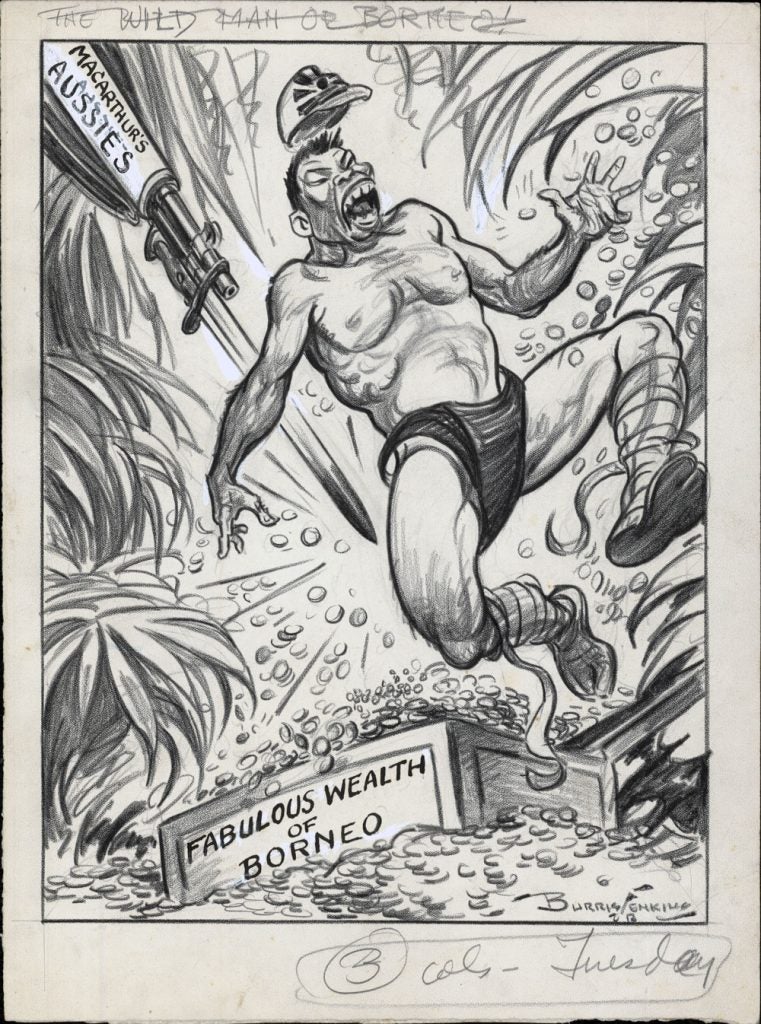
“The Wild Man of Borneo” (June 12, 1945)
by Burris A. Jenkins, Jr. (1897-1966)
15 x 18 in., ink and crayon on board
Coppola Collection
Burris Jenkins Jr. was the son of a prominent Kansas City minister, war correspondent and newspaper editor. Jenkins Jr. was a popular sports cartoonist, whose work appeared in the New York Journal-American from 1931. His humorous published verses were also popular. Although best known for his sports themes, Jenkins was also a skilled courtroom illustrator and editorial cartoonist.
Jenkins was not afraid to provoke, and he has some strong WW2 examples, including one of the rare direct commentaries on concentration (death) camps. Among his best-remembered cartoons are his angry piece on the discovery of the dead Lindbergh baby, and his sentimental image of Babe Ruth’s farewell to Yankee Stadium.
He was fired from his first job at the Kansas City Post for a series of pessimistic Christmas cartoons, a firing that prompted his father’s resignation from the same newspaper.
His father was an interesting guy. Jenkins, Sr (1968-1945) was ordained in 1891 and served as a pastor in Indianapolis. He received advanced degrees from Harvard and went on to serve as a professor and president of the University of Indianapolis and president of Kentucky University. He left Kentucky to return to Kansas City as pastor of the Linwood Boulevard Christian Church. The church burned in 1939, and Jenkins chose Frank Lloyd Wright as the architect for the church’s new home overlooking the Country Club Plaza.
Jenkins served as editor of the Kansas City Post from 1919 to 1921, hoping to fight for the establishment of the League of Nations. The Jenkins, Sr., biography tells the story about his leaving the Post slightly differently that for the son: “After two years, it became necessary for him to choose between the newspaper and his pulpit and, without hesitation, he resigned from the Post.”
“Live dangerously!” Jenkins would thunder from the pulpit, embracing his own philosophy against all adversaries. Unconventional in nearly every aspect of his chosen field, Jenkins often preached from non-Biblical texts, such as the latest book or his travels abroad. The church frequently hosted motion pictures, dances, card games, and fundraising boxing matches. These activities led to opposition to Jenkins and his Community Church from other churches in the city.
The island of Borneo, with its oilfields and strategic location for the offensive against British Malaya and Dutch Java, was one of the prime targets of Japan’s military offensive of 1941-42. The Japanese systematically and swiftly secured their objectives in Borneo during the early months of their push into the resource-rich Southern Area (South-East Asia) following Pearl Harbor.
In 1945 the task of retaking from the Japanese the former British Borneo territories of Sarawak, Brunei, and North Borneo (Sabah) was entrusted to the Australian Imperial Force (AIF). The 20th and 24th Brigades of the 9th Division launched an amphibious offensive, codenamed OBOE 6.
In order to facilitate his re-conquest of the Philippines, MacArthur struck a deal with the Dutch that he be given “complete authority in the East Indies during any military operations.” In return, he promised to restore Dutch authority in their colonies as rapidly as possible. Therefore, the recapture of the Netherlands East Indies, particularly Java, became part of MacArthur’s plans. The seizure of Borneo was to offer bases to launch his offensive against Java. Furthermore MacArthur argued that the Bornean oilfields would be denied the enemy and instead deployed to Allied advantage.
Nonetheless MacArthur had no intention of committing American land forces in the Borneo campaign. Instead, Australian troops would spearhead the offensive there. Two main landings were undertaken by the Australians in North Borneo on June 10 and June 20.

